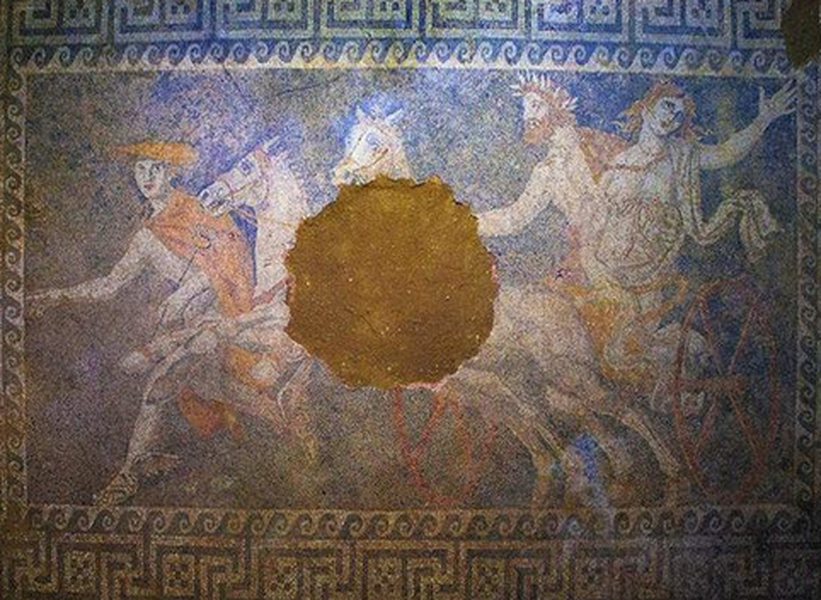Archaeologists discover mural depicting Hades' abduction of Persephone


The abduction of Zeus' daughter Persephone by Hades, or as the Greeks referred to the god, Plouton (later known by the Romans as Pluto), is one of Greek mythology's hallmarks. But a mosaic discovered in Greece adds a third figure, the Greek god Hermes, into the mix.
When Greece's Culture Ministry first announced the mosaic find on Sunday, the archaeologists suspected that the pebbled mosaic floor may have depicted Philip II, Alexander the Great's father, as Hermes' passenger. But the discovery of Persephone on the mosaic, found in Amphipolis in northern Greece, has confirmed that the mosaic depicts the classic story of Pluto and Persephone. "It is obvious this is the mythological representation of the abduction of Persephone by Pluto," the Greek ministry said in a statement.
The archaeologists now believe that the bearded passenger in Hermes' chariot is the god Pluto, not Philip II. Hermes guided souls to the underworld, so as lord of the underworld, it makes sense that Pluto would ride along with Hermes. As for Persephone, the mural depicts her with her hand "raised in fear," Discovery News notes.
The Week
Escape your echo chamber. Get the facts behind the news, plus analysis from multiple perspectives.

Sign up for The Week's Free Newsletters
From our morning news briefing to a weekly Good News Newsletter, get the best of The Week delivered directly to your inbox.
From our morning news briefing to a weekly Good News Newsletter, get the best of The Week delivered directly to your inbox.
Discovery News adds that the revelation "directly links" the Amphipolis tomb to royal tombs in Vergina, Greece — the abduction of Persephone was also depicted in a mural at King Philip II's tomb.
A free daily email with the biggest news stories of the day – and the best features from TheWeek.com
Meghan DeMaria is a staff writer at TheWeek.com. She has previously worked for USA Today and Marie Claire.
-
 The elite falcon trade in the Middle East
The elite falcon trade in the Middle EastUnder the Radar Popularity of the birds of prey has been ‘soaring’ despite doubts over the legality of sourcing and concerns for animal welfare
-
 A running list of the international figures Donald Trump has pardoned
A running list of the international figures Donald Trump has pardonedin depth The president has grown bolder in flexing executive clemency powers beyond national borders
-
 Mixed nuts: RFK Jr.’s new nutrition guidelines receive uneven reviews
Mixed nuts: RFK Jr.’s new nutrition guidelines receive uneven reviewsTalking Points The guidelines emphasize red meat and full-fat dairy
-
 Nobody seems surprised Wagner's Prigozhin died under suspicious circumstances
Nobody seems surprised Wagner's Prigozhin died under suspicious circumstancesSpeed Read
-
 Western mountain climbers allegedly left Pakistani porter to die on K2
Western mountain climbers allegedly left Pakistani porter to die on K2Speed Read
-
 'Circular saw blades' divide controversial Rio Grande buoys installed by Texas governor
'Circular saw blades' divide controversial Rio Grande buoys installed by Texas governorSpeed Read
-
 Los Angeles city workers stage 1-day walkout over labor conditions
Los Angeles city workers stage 1-day walkout over labor conditionsSpeed Read
-
 Mega Millions jackpot climbs to an estimated $1.55 billion
Mega Millions jackpot climbs to an estimated $1.55 billionSpeed Read
-
 Bangladesh dealing with worst dengue fever outbreak on record
Bangladesh dealing with worst dengue fever outbreak on recordSpeed Read
-
 Glacial outburst flooding in Juneau destroys homes
Glacial outburst flooding in Juneau destroys homesSpeed Read
-
 Scotland seeking 'monster hunters' to search for fabled Loch Ness creature
Scotland seeking 'monster hunters' to search for fabled Loch Ness creatureSpeed Read
